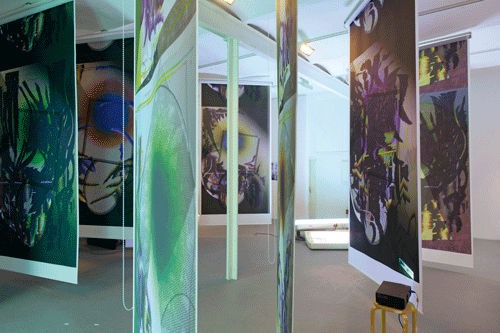DAS INSTITUT mit UNITED BROTHERS und Nhu Duong
Halle für Kunst
Halle für Kunst

DAS INSTITUT – the collaborative side-project of Kerstin Brätsch and Adele Röder – appears to be fuelled by the sense of liberation that comes with temporarily abandoning one’s day job. Since 2007, the project has allowed the painters to emerge from behind their canvases and to develop another practice which, while treating art as just another commercial market, paradoxically depends upon breaking taboos to create credibility. This exhibition ‘BLACKY Blocked Radiants Sunbathed’ is part of a series of collaborations between DAS INSTITUT and UNITED BROTHERS (the Japanese artist-brothers Ei and Tomoo Arakawa), which began at Kunsthalle Zurich in 2011 and included the Swedish fashion designer Nhu Duong at the Halle für Kunst stop. While the series was conceived after the Fukushima Daiichi nuclear disaster, this show’s title alluded to another kind of radiation: Tomoo Arakawa’s Fukushima-based tanning salon is called Blacky Iwaki.
The gallery space was filled with tanning beds, video projections and semi-transparent roller blinds, the latter emblazoned with Brätsch and Röder’s familiar, spray-paint-like abstractions and titled BLACKY Blocked Radiants Sunbathed Roller Blinds (2011). The two-part opening night performance began when the blinds were ceremoniously rolled up and the tanning beds were switched on. DAS INSTITUT’s works are characterized by a casual experimentalism usually found at art schools, so it was fitting that about twenty art students from the Hochschule für bildende Künste Hamburg joined in for a choreographed dance routine. Energetically instructed by a whistle-blowing Ei Arakawa, the amateur dancers moved awkwardly to a traditional Japanese song, occasionally waving patterned scarves or holding up naive figurative paintings made by Ei as a child. For the second act, members of the audience were encouraged to dance around the streets near the gallery, donning an array of hoods, overalls, trousers and incongruous-looking garments, all designed by Duong. When they returned – a little more sluggishly than when they left – the chanting and whistling stopped, the blinds were rolled down, and the tanning beds were switched off. For the remainder of the exhibition, the beds and blinds resembled theatrical props more than art works – a quality reinforced by a dual video projection of a similar dance-based performance held for the 2011 Reconstruction Festival in Fukushima.
The exhibition’s light-hearted, improvisational and art-world-insider tones brought to mind shows by the performance-based ensemble Chicks on Speed – although DAS INSTITUT downplays gender in favour of design. While the tanning beds and radiantly-patterned blinds linked the UV rays of Tomoo Arakawa’s tanning studio to the Fukushima disaster, the radiation motif served as just another prop – with Brätsch and Röder offering not so much a focused inquiry as a framing of loose associations. Perhaps celebrating the diminished political currency of contemporary art, ‘BLACKY Blocked Radiants Sunbathed’ suggested that there was a time when an exhibition linking nuclear meltdowns to fashion and carefree dance routines would have provoked debate rather than just an air of indifference.














